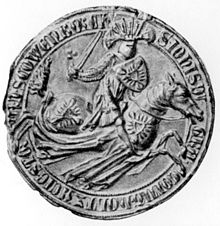John III, Count of Holstein-Plön
| John III, Count of Holstein-Plön | |
|---|---|

Seal of John the Mild
|
|
| Spouse(s) | Catherine of Silesia-Glogau Merislawa of Schwerin-Wittenburg |
| Father | Gerhard II, Count of Holstein-Plön |
| Mother | Agnes of Brandenburg |
| Born | c. 1297 |
| Died | 27 September 1359 |
John III of Holstein-Plön (ca. 1297–1359), called John the Mild, was a Count of Schauenburg and Holstein-Plön and Holstein-Kiel, ruling Holstein-Plön (1312–1316 and again 1350–1359) and Holstein-Kiel (1316–1359). Together with Count Gerhard III of Holstein-Rendsburg John III was the lord ruling in guardianship the Danish Duchy of Schleswig 1332–1340. He was known as “John the Mild”.
He was the son of Count Gerhard II the Blind of Holstein-Plön and of the Danish Queen Dowager Agnes of Brandenburg, a fact that made him a half-brother of Eric VI and Christopher II. In 1312 John and his brother Gerhard IV succeeded their father as co-ruling counts of Holstein-Plön. In 1316 John III inherited Holstein-Kiel from his father's cousin John II the One-Eyed and thus left Holstein-Plön for his brother Gerhard IV as sole ruler. A wealthy man by inheritance John very early acted as a powerful local prince funding Danish warfare and co-operating with his cousin Gerhard III.
His financial support of the Danish kings quickly made him one of their leading creditors with his chief possession in Funen. During the rebellion against Christopher II 1326 John supported Gerhard III and the Danish magnates and enlarged his Danish possessions. The growing rivalry between John III and Gerhard III led him to support the restoration Christopher as a king 1330 but the co-operation between the two half-brothers in 1331 against Gerhard III ended in a defeat. John politically survived this setback but had to accept Gerhard III as his superior.
From 1332 to 1340 John was the master of Denmark east of the Great Belt. However, by 1332 he lost Scania which rebelled against the German rule submitting to the Swedish king. Though a kind of a co-ruler with Gerhard III, John did not play a very great political role and preferred to concentrate on his economic profit – like Gerhard III he was pestered by his own minor creditors. After Gerhard III's death and the collapse of Holstein-Rendsburg's rule 1340 John at first co-operated with King Valdemar IV in order to get his money back but during the following years he was slowly but surely outmaneuvered from his Danish possessions by war and by economic transactions.
...
Wikipedia
